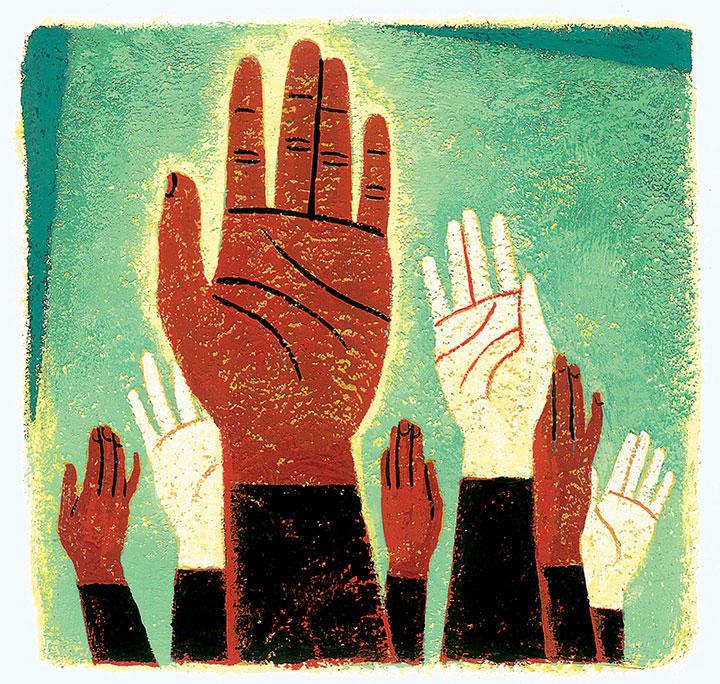Getting to ‘Yes’ — Building Grad-School Diversity

As thousands of prospective graduate students wrap up applications this fall, many will hope for an invitation to visit a Princeton department in early 2019. Those who come will hear about everything from academic resources to the DBar, but some say they don’t hear enough about diversity in the community they would be joining.
“I was concerned about whether or not I would find my people,” recalls Sean Luna McAdams, a third-year Ph.D. student in politics, “though that cut across a lot of different things, not just being Latino” in a predominantly white community.
While racial diversity is just one factor students consider, it may carry more weight than departments realize. According to the Graduate School’s website, while the yield rate for all graduate students has hovered around 50 percent for the past eight admission cycles, the rate for domestic applicants who self-identified as black/African American and who accepted offers of admission declined from 73 percent in 2011–12 to just 40 percent in 2018–19. For domestic Hispanic/Latino students with admission offers, a 70 percent yield in 2011–12 dropped to 50 percent in 2012–13 and has remained in that ballpark since.
Yields vary from year to year, according to Renita Miller, the Graduate School’s associate dean for access, diversity, and inclusion, but the combined yield for underrepresented minorities has been close to or above the yield for all students for several years. An increasingly diverse applicant pool has led to more underrepresented minority students receiving offers of admission, she said, and the total number of these students enrolling has been “steadily climbing over the last several years.”
Some current grad students said they felt a lack of diversity was so endemic to academia that they couldn’t realistically take it into account when evaluating Princeton.
“I didn’t consider it because I didn’t expect there to be much diversity in the first place,” said James Martin, a fifth-year Ph.D. student in molecular biology. “I was surprised during my grad school interviews that I was usually the only person of color at each school I went to, but when it came to making the final decision after realizing that, I thought, ‘This is just going to be a trial anyway.’”
Graduate students told PAW of the importance of discussing diversity issues during recruiting. Martin recalls other schools scheduling more diversity programming on their visit days than he found at Princeton. Luna McAdams told how, during his visit to the politics department, he contacted Latino grad students on his own initiative and learned of Princeton’s Latino Graduate Student Association — of which he is now president. “I was surprised to hear there was an organization, so that helped me in some of my concerns,” he said.
A new program as of October, Princeton Prospective Ph.D. Preview, gives interested students a chance to visit and learn about the admission process before applications are due. The departments of molecular biology, ecology and evolutionary biology, and Near Eastern studies also have diversity-related visitation programs, Miller said.
“We find that underrepresented minority and first-generation low-income students who have an opportunity to visit and learn more about Princeton prior to the application process are more likely to apply and accept our offer,” she explained.
Laura De Olden, the associate director of graduate student life and diversity initiatives at the Woodrow Wilson School, feels she can relate to students “as a first-generation Latina” and aims to “ensure that all members of the Woodrow Wilson School community feel respected, included, and supported.” A few other departments, including neuroscience and chemistry, also have administrators who run diversity initiatives.
But most departments lack these designated resources, and students believe they need to be more direct with prospective students about diversity in their program and the difficulties of graduate school.
“If you come in hearing from an older student saying, ‘These are the struggles, but this is how I made it through,’ it really helps provide a comfortable and safe environment to say, ‘Yes, this will be hard, but I know the path to navigate,’” said Martin.
Francine Camacho, a fifth-year Ph.D. student in quantitative and computational biology, agrees. She recalled two Princeton students of color advising her against attending during her visit, and aims to be similarly forthcoming.
“I don’t try to sell Princeton as a utopia, and I try to be honest about my experiences,” she said. “I usually say graduate school is hard and there is no perfect program or school, each with their own problems, but I have grown to love and appreciate Princeton in my own way.”
While Camacho struggles to encourage students to come to Princeton knowing the isolation she has often felt, she feels that the culture is changing and will improve if more students of color decide to matriculate. Ultimately, she hopes to “remind them that students who look like us and talk like us deserve to be at Princeton.”












No responses yet